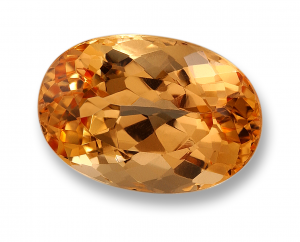 This colorless gemstone comes in many hues, surely a contradiction in terms but in fact the color Topaz displays is entirely a result of the impurities within the stone. A silicate containing aluminum and fluorine, it is found in many different countries, colored depending on the seam of rock in which it has been formed.
This colorless gemstone comes in many hues, surely a contradiction in terms but in fact the color Topaz displays is entirely a result of the impurities within the stone. A silicate containing aluminum and fluorine, it is found in many different countries, colored depending on the seam of rock in which it has been formed.
Topaz, both opaque and translucent, can be yellow, red or orange, blue, brown or even gray, the varieties are enormous. Perhaps pink is the rarest version but it is this variety which gives you the chance to select purely on color, perhaps your favorite color.
Orange Topaz is the gemstone which represents Utah in the USA; it is regarded as the November birthstone. Not to be outdone, Texas’ choice is the Blue Topaz which is rare in its natural form so is generally heat treated and irradiated to deepen the hue.
Likewise the Mystic Topaz is a colorless version which needs a coating treatment to produce the rainbow effect.
The Imperial Topaz can range from yellow through to the much rarer pink though the Brazilian version is more vivid again with a really strong yellow, going perhaps even to gold and violet. These strong colors are in the natural state but that color can sometimes fade when exposed to regular sunlight.
Where are the best Topaz gemstones found?
Topaz is found were there are igneous rocks, a good example being granite. It crystallizes in the veins within the lava flows but that suggests small stones. In actual fact, topaz sometimes occurs in the size of boulders weighing hundreds of pounds. Examples that have come from Brazil can be sometimes seen displayed in museums but the largest ever is a recent find of 22,892.5 carats, discovered in the USA.
Topaz is found over many parts of the World, Russia, Australia, USA, West Africa and parts of Europe. However, the mines in Minas Gerais in Brazil are the most important suppliers of Topaz in the world today.
In historical times, the word Topaz was often used to mean any gemstone hence long references to Topaz in a book on minerals published in the middle of the 17th Century. Those references are not to be taken as meaning the Topaz as you would know it today, and sometimes the descriptive text clearly illustrates that the gemstones were not Topaz. However Topaz is one of the gemstones in the twelve gates to Jerusalem because it was regarded as a protector from enemies and at the same time had such an attractive appearance; it was a symbol of beauty if you like and the Romans dedicated it to Jupiter.
The Portuguese Crown, the Braganza, contains a huge stone, weighing 1680 carats which was thought to be a diamond when in fact it is a topaz, ample proof of its qualities.
What are the physical properties of Topaz?
Symmetry Orthorhombic dipyramidal
Crystal Prismatic
Specific gravity 3.49 – 3.57
Optical properties Biaxial
The Topaz offers you a whole range of color (if you were looking for blue gemstones – then aquamarines are an option as well) and as a result has been a gemstone that every buyer should consider when looking for jewelry. There are cheaper alternatives which have meant the topaz has perhaps become a more peripheral gemstone but that in no way detracts from its qualities; you should bear it in mind especially in a ring and as a birthday gift.
Learn more about how to buy Topaz in the next article in our Gemstone series.
